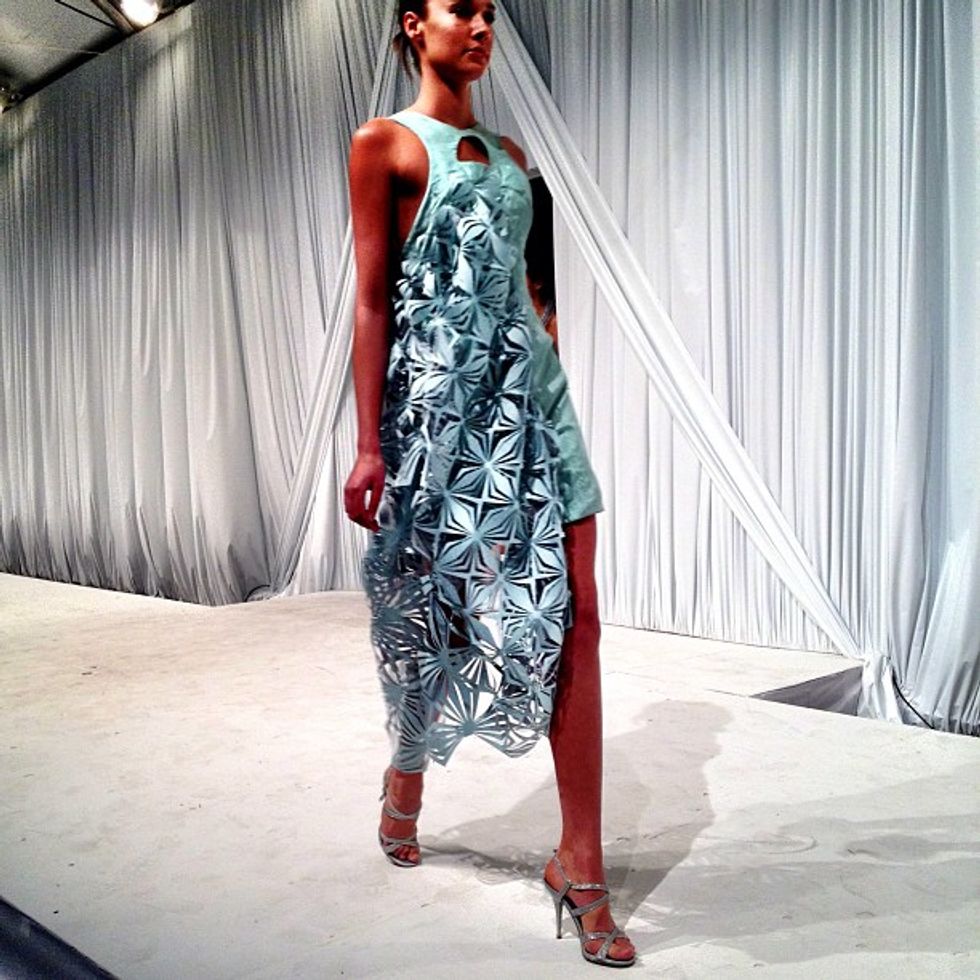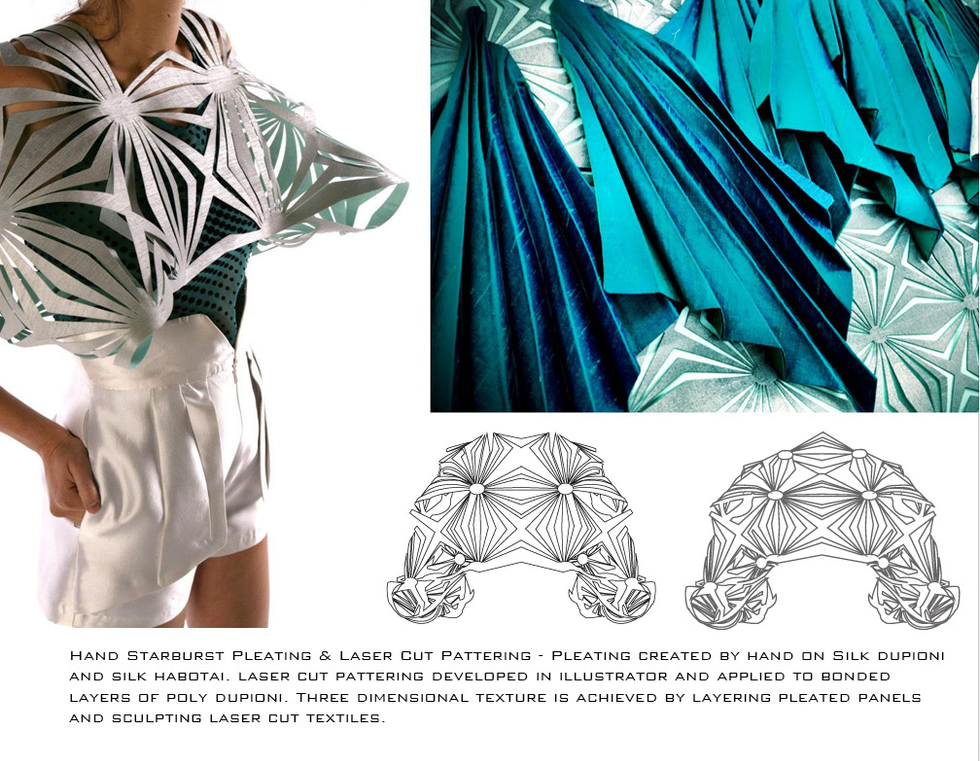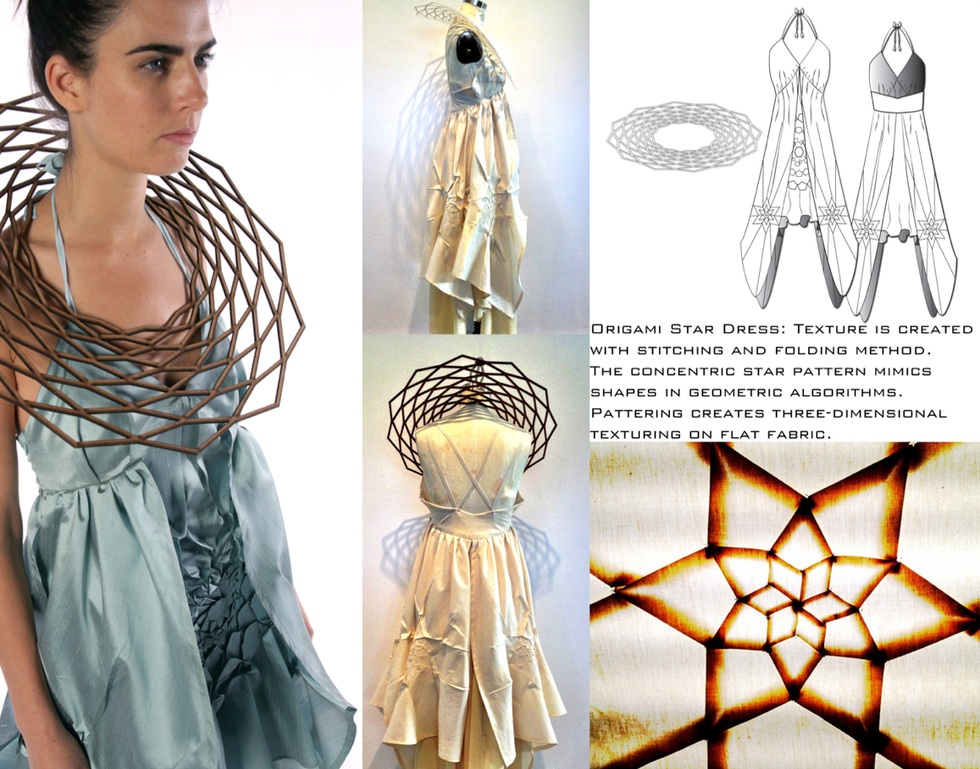For CCA grad Tiśina Parker, fashion design is more than stylish, trend-setting apparel, and her collection—4th Dimension—for CCA's graduation fashion show illustrated just that. She delved deep into mathematics, all the way to the 4th dimension, an abstract concept that she says "is derived by generalizing the rules of three-dimensional space by applying complex rules of vectors and coordinate geometry." The heady concept she used for this work can be found both in nature and architecture, and she complemented her designs with origami and textile folding, which also build upon this same idea (but are much easier for us laymen to understand!).
Parker taught herself how to sew before attending CCA and has an innate sense of textiles thanks to her heritage—her grandmother is a notable Native American basket weaver. Growing up watching her grandmother weave traditional Miwok basketry and using natural materials explains Parker's interest in the craft of textiles and her later fascination with knitwear. The thread behind all of her work stems from her passion for environmental sustainability and the complex set of challenges that poses for the fashion industry. "I believe that our understanding of solutions for sustainable fashion and social justice is as diverse as creative designing minds," she says. "There is not one definition of what is sustainable, and we should not limit ourselves in the exploration for solutions."
It was Parker's cross-disciplinary approach and commitment to creativity, innovation, and sustainability that really made her stand out and landed her 7x7's Emerging Talent Award. Here, a Q&A that lets the designer speaks for herself.
Describe yourself as a designer in three words.
Innovative, Investigative, Intelligent
What kind of woman are you designing for?
In the 4th Dimension collection, I am designing for a woman who is fashion forward far into the future. She is feminine, sharp, and edgy. Her style marks her as separate from the rest and is a badge of her intellect, originality, and individuality. She dresses far beyond what current trend dictates.
The 4th Dimension collection was inspired by ideas in computational architecture?
Research, development, and discovery fuel my design process. I'm interested in ways that scientific, mathematical, architectural, and textile developments can inform my design. I was drawn to architect Michael Hansmeyer's work in computational architecture—his approach was not just to design a “thing” but to design a process. He creates algorithms and applies mathematical equations to simple three-dimensional forms. I love the complexity of the final form of his work and the simplicity in the consistent repetitive application. I wanted to try and apply the same idea to fashion, garments, and fabric. To me, the only limit within design and exploration is time.
How did you learn to use a laser cutter and 3D printer?
I got a work-study job in the rapid prototyping studio at CCA so I could get closer to these tools. The laser cutter is much easier to understand than 3D printing. Though printing an object is not the biggest challenge, designing in 3D modeling programs has a big learning curve.
What do you see as the future of fashion?
I see fashion becoming more diversified by our understanding of other cultures, innovations in technology, craft, and sustainability. I think we will see micro design bubbles, localized within regions. I see conceptual fashion and intelligent ideas represented more within high-end markets. I also see smaller runs designed in streamlined production processes to cut down on waste and minimize environmental impact. These smaller runs in production would push up the value of individual garments and create more unique finds for the consumer while still stimulating creativity and pace of cutting-edge fashion design.
If you could dream up your perfect job in fashion, what would it be?
I would love to work on innovations in textile development in ways that meet our global needs of environmental awareness and sustainability. I would also love to use these developments in conceptual design in collaboration with designers in the tech industry, architecture, science, and interactive design. These designs would not necessarily be worn by everyone as ready-to-wear, but they would largely inform trends in ready-to-wear and keep us interested in fashion as an art form.
If you could produce a fashion shoot of your collection anywhere in the Bay Area, where would it be?
The new lights on the Bay Bridge could make an amazing backdrop for a night shoot. I also like the architecture of the Contemporary Jewish Museum—the shape and design of the exterior of the building really informed the foundation of my collection.
If you could sell your clothes at any Bay Area store, what would they be?
M.A.C., Loft 1513, Fawn, The Workshop Residence, and Barneys.
Favorite trend from the Fall 2013 runways?
Complex textile patterns, use of texture, and bright colors.
Your advice for San Franciscans on dressing for the city's microclimates and maintaining a sense of style?
Having a good stylish jacket, an array of scarfs, dressing in layers, and unique jewelry are key in SF. I also think that a personal style is essential to the individuality that is celebrated in our city. Let your personality express this, and go all out. What better place to do it in than San Francisco?











































